Deforestation is the permanent destruction of forests, which significantly impacts the global carbon cycle and the environment. Forests are critical in regulating the Earth's climate. They store large amounts of carbon dioxide through the process of photosynthesis and are thus carbon sinks. However, deforestation disrupts the carbon cycle by releasing carbon dioxide into the atmosphere and reducing the number of trees that absorb carbon emissions. This effect makes deforestation a major contributor to global greenhouse gas emissions, accounting for around 15% of human-caused emissions.
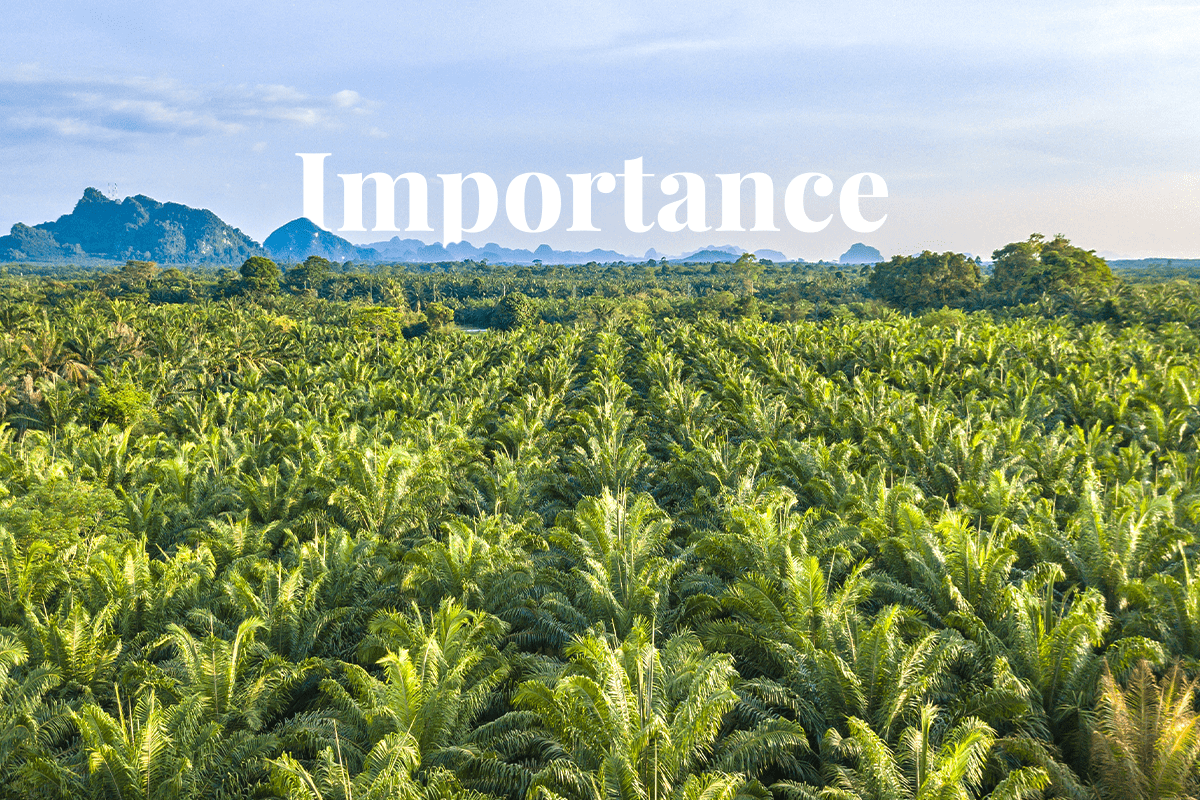 View of on oil palm tree plantation.
View of on oil palm tree plantation.
Deforestation has severe environmental impacts and consequences. Over 420 million hectares of forest have been lost since 1990. The loss of natural habitats and biodiversity has led to a species extinction rate that is 100 to 1,000 times faster than the natural rate. Every second, a forest the size of a football field is cut down, and every year, forested areas equal to the size of Portugal are lost. Clearing forests not only reduces their carbon storage capacity but also increases greenhouse gas emissions due to the reduction of vegetation cover. Deforestation also disrupts water cycles and soil stability, leading to erosion, changes in rainfall patterns, and flooding. Furthermore, deforestation contributes to a loss of ecosystem services and degrades the resources many communities depend on for their livelihoods.
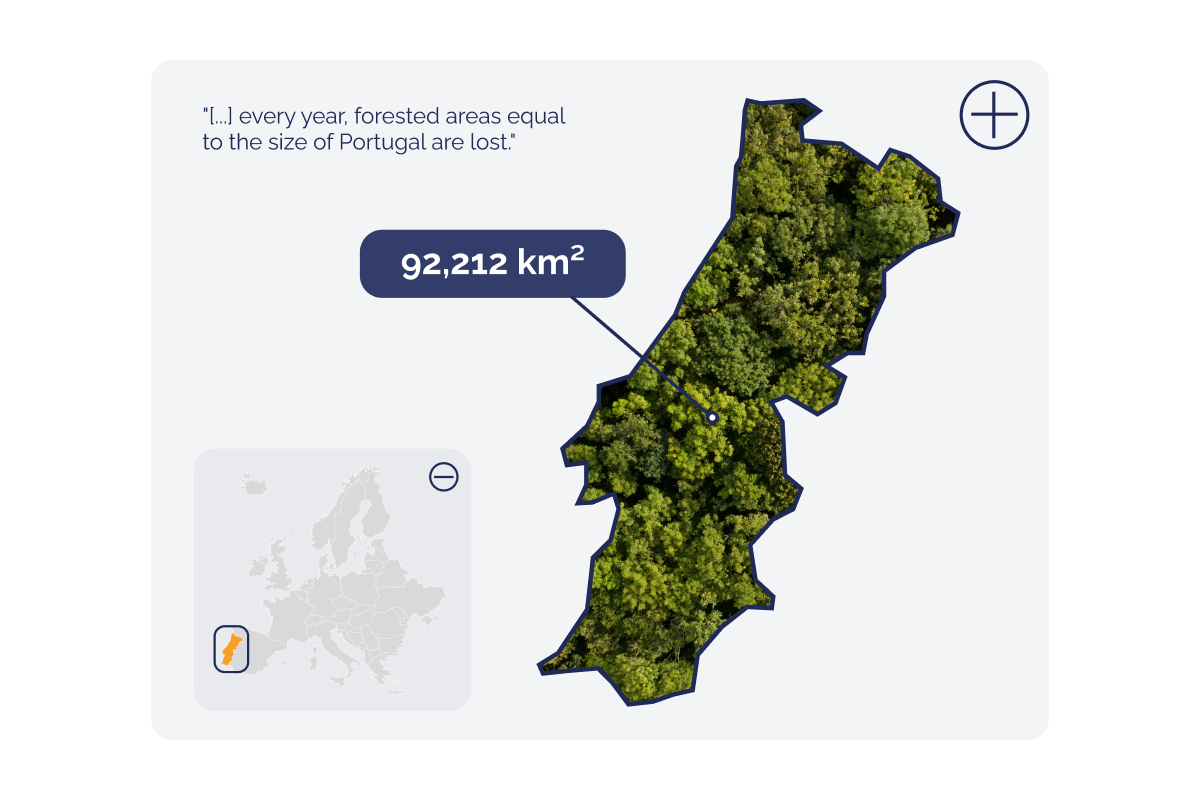 Map of Portugal; Source: ourworldindata.org/deforestation.
Map of Portugal; Source: ourworldindata.org/deforestation.
This article will explore several causes of deforestation, including the expansion of agricultural land, urbanisation, and increased demand for resources such as timber. Large-scale agriculture is responsible for more than 70% of deforestation globally. The growing population fuels the demand for agricultural land, leading to the clearing of forests to create space for food production. Urbanisation, industrialisation, and infrastructure development have also contributed significantly to deforestation, as growing cities require more land for housing, factories, and transport systems.
You can help reduce deforestation with DGB Group and contribute to creating a greener planet for all. You can compensate for your carbon footprint by purchasing high-quality carbon units from our verified nature-based projects, which restore forests and protect biodiversity. You can green your business and support sustainable practices with our trees for businesses by planting trees on behalf of your customers or employees to showcase your commitment to the environment. Or you can make a personal impact by subscribing to our tree planting programme, where your monthly contribution directly funds the growth of vibrant forests.
What is deforestation?
Deforestation is the conversion of forests, through the clearing of trees, to other land uses or the long-term reduction of tree canopy cover to below 10%. Deforestation is often done for commercial or human needs. This removal of forests is a significant contributor to climatic instability and biodiversity loss. Deforestation is therefore one of the most pressing environmental issues facing the world today.
Deforestation occurs due to both natural and human-induced events. Natural events, such as forest fires, hurricanes, and droughts, can destroy forests. However, human activities are the major cause of deforestation.
Deforestation negatively impacts the environment and human life. One of the primary adverse effects is the loss of biodiversity. Deforestation reduces plant and animal habitats, putting them at risk of extinction. Forest loss also leads to soil erosion, which may result in landslides and the contamination of water sources. Deforestation is also a major contributor to climate change. Forests act as carbon sinks, absorbing large amounts of carbon dioxide and other greenhouse gases from the atmosphere. So, when they are cut down through deforestation, the carbon trapped in their biomass is released into the atmosphere. Carbon dioxide is a greenhouse gas that absorbs and radiates heat, causing rising temperatures and changing environmental conditions.
Deforestation is most severe in tropical forests in South and Central America, Africa, and Southeast Asia, where millions of hectares of forest are destroyed each year. Primary forests, which contain the world's most extensive and oldest trees and provide habitats for rare and endangered species, are among the worst affected.
 Elephant in an old forest. Mana Pools National Park, Zimbabwe.
Elephant in an old forest. Mana Pools National Park, Zimbabwe.
In this article, we will explore the 10 main causes of deforestation, the effects of deforestation, and what we can do to halt current deforestation rates.
If you want to help mitigate deforestation, invest in nature with DGB
1. Expansion of agricultural land
One of the leading causes of deforestation is the expansion of agricultural land, accounting for more than 70% of deforestation rates. Agricultural practices, such as clearing vast areas of forest for farming, logging, and fuelwood use, are primary activities that contribute significantly to deforestation. Both subsistence farming, where farmers grow crops to feed their families, and commercial agriculture, which produces crops for export or domestic use, are responsible for hundreds to thousands of hectares of forest being taken down.
Subsistence farming is common in many countries, and it is often the only way for millions of people to sustain their families. Farmers in these areas typically clear small plots of land by cutting down trees and burning them. Unfortunately, this practice is usually unsustainable, as farmers are forced to clear a larger land surface when the soil becomes infertile. Commercial agriculture, on the other hand, involves clearing vast areas of forest to make way for large-scale production of cash crops like soy and palm oil.
Read more: What is sustainable land management?
Some of the top agricultural products responsible for deforestation include palm oil, soy, beef, and logging for timber. Palm oil plantations, in particular, have been a major driver of tropical deforestation in Southeast Asia and Central Africa, where vast areas of land have been cleared for oil palm plantations. Soybean cultivation is another significant driver of deforestation in South America, where large swaths of tropical rainforests have been cleared to make way for soy plantations.
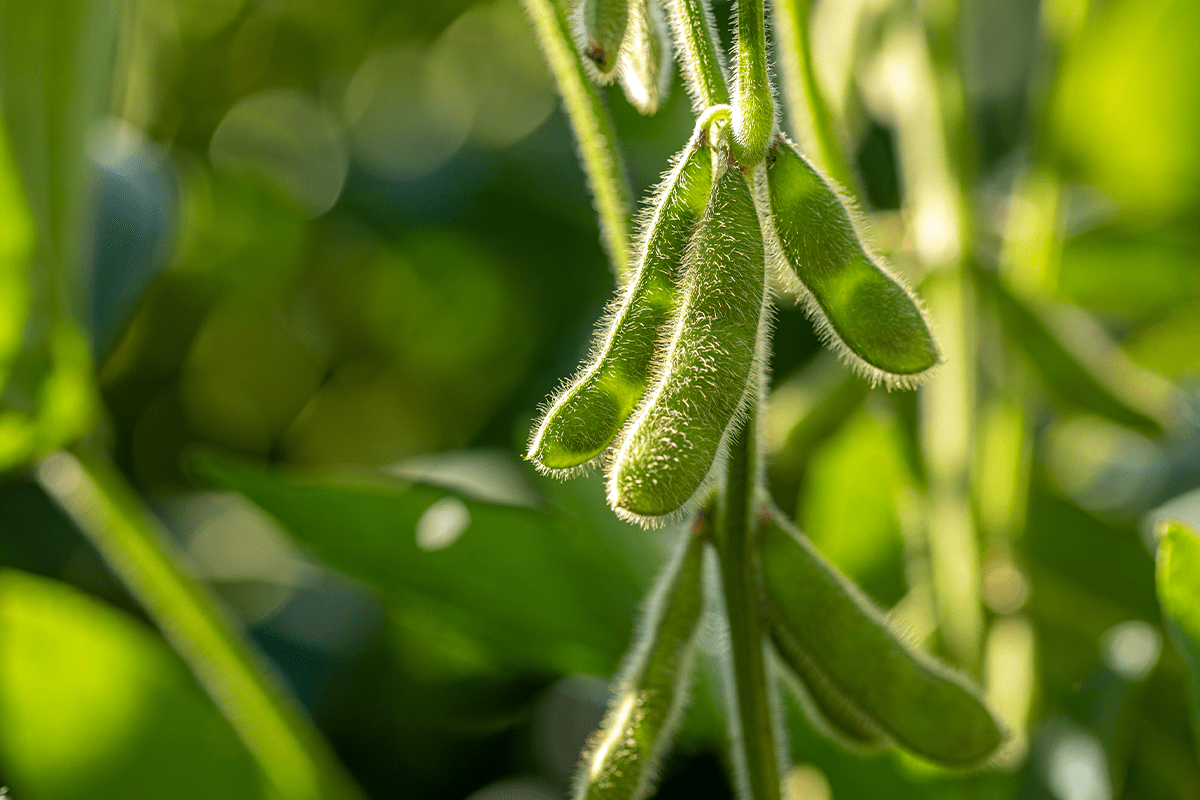 Soy plantation, macro details.
Soy plantation, macro details.
The environmental impacts of deforestation caused by agricultural expansion are severe. Forests are critical carbon sinks, and their destruction releases harmful greenhouse gases into the atmosphere. Deforestation also leads to biodiversity loss, destroys the natural balance of ecosystems, and contributes to the habitat loss of many animal species.
2. Livestock grazing
Livestock grazing, particularly for meat production, is also a significant cause of deforestation. Farmers often clear vast areas of land to create grazing pastures for their livestock, contributing to the loss of forested land. The degradation of soil resulting from overgrazing often also leads to repeated clearing and deforestation.
The global demand for meat also drives the expansion of land needed for livestock farming. In addition to pasture land, large amounts of feed crops like soy are grown to feed livestock. In South America, massive forest areas have been cleared to make way for soy plantations, much of which are used to feed livestock. This increase in demand for meat puts tremendous pressure on ecosystems, particularly in the Amazon Rainforest, which is one of the most precious but threatened ecosystems on the planet.
Read more: Deforestation in the Amazon Rainforest: causes, effects, solutions
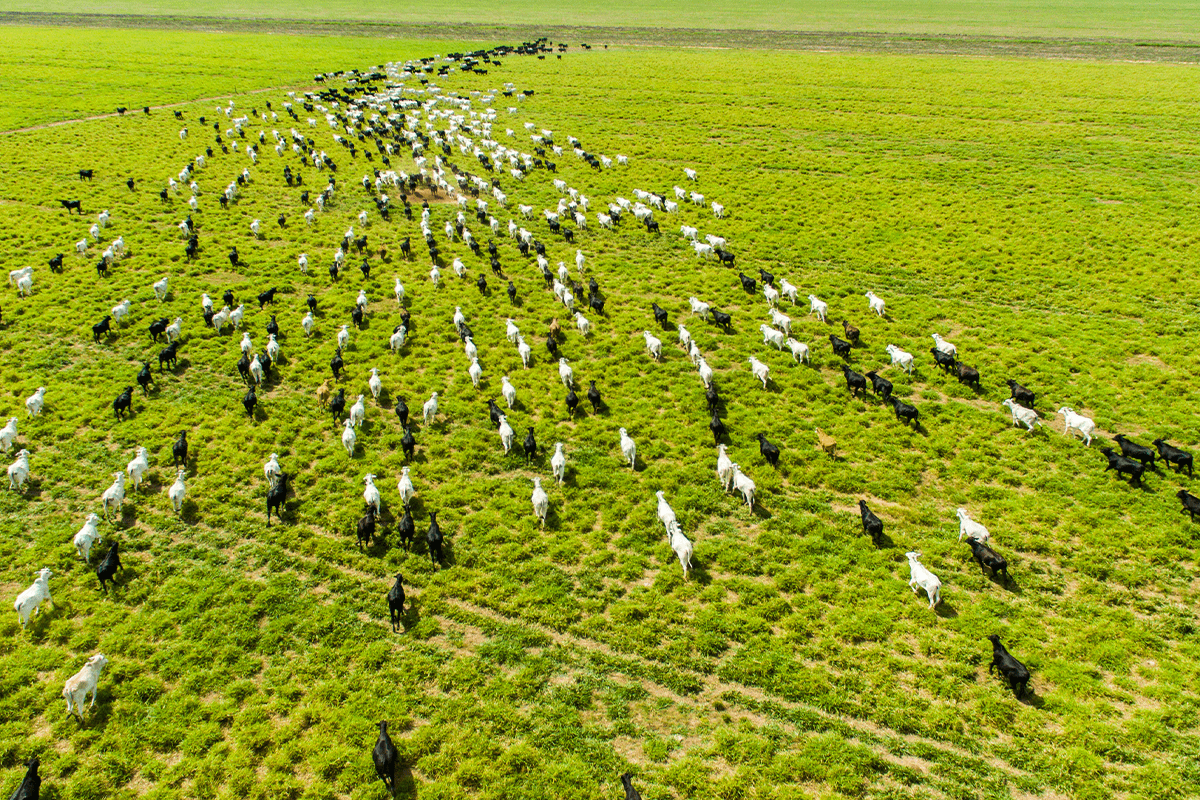 Livestock running in a field. Cattle ranch Nelore, Brazil.
Livestock running in a field. Cattle ranch Nelore, Brazil.
Cattle ranching is one of the primary culprits of deforestation in the Amazon Rainforest. As beef demand increases, farmers are clearing more land for grazing and creating new pastureland. This practice has led to the destruction of millions of hectares of tropical rainforests in the region. In addition, tropical deforestation is driving Indigenous people from their homes and disrupting the natural habitats of native animal species.
One potential solution to the problem of livestock grazing and its impact on deforestation is a shift towards cyclical agriculture. This method involves rotating crops and livestock grazing to maintain soil fertility and avoid overgrazing. In addition, it reduces the need for large areas of pastureland and minimises the pressure placed on forested ecosystems.
Read more: How regenerative agriculture is transforming sustainable farming
3. Logging and wood harvesting
Logging and wood harvesting are among the leading causes of deforestation across the world, especially in North America and Russia. Forests are valuable resources that provide timber products for construction, furniture, and paper. Unfortunately, this often leads to unsustainable logging practices that destroy millions of hectares of forested land every year.
Sustainable forestry practices involve selectively harvesting trees and allowing time for the forest to regrow. However, unsustainable logging is a multi-billion-dollar industry fueled by global demand for low-cost timber products. In Indonesia, nearly half of the country's forests have been devastated due to unsustainable logging practices.
Purchase our carbon credits and help restore forests
When forests are degraded due to logging practices, they become much more vulnerable to conversion to other land uses like mining, agriculture, and settlement. The soil often becomes compacted, making it difficult for new trees to grow. The loss of tree canopy allows for increased sunlight to reach the forest floor, which can spur the growth of invasive species that choke out native flora. Once a forest is degraded, it becomes much easier for developers to obtain permits to clear the land for other uses.
To combat the destructive impacts of logging and wood harvesting, efforts are being made to stop illegal logging, protect forested areas, reform trade agreements, and educate local communities. Protecting forested areas involves creating protected areas, like national parks and wildlife reserves, that are off-limits to logging and other development activities. Reforming trade agreements involves holding companies and countries accountable for their environmental impact and requiring them to adopt sustainable forestry practices. Lastly, educating local communities about the importance of forests and sustainable forest management practices can help change behaviour and prevent further deforestation.
Read more: Sustainable forestry practices combatting deforestation in Canada
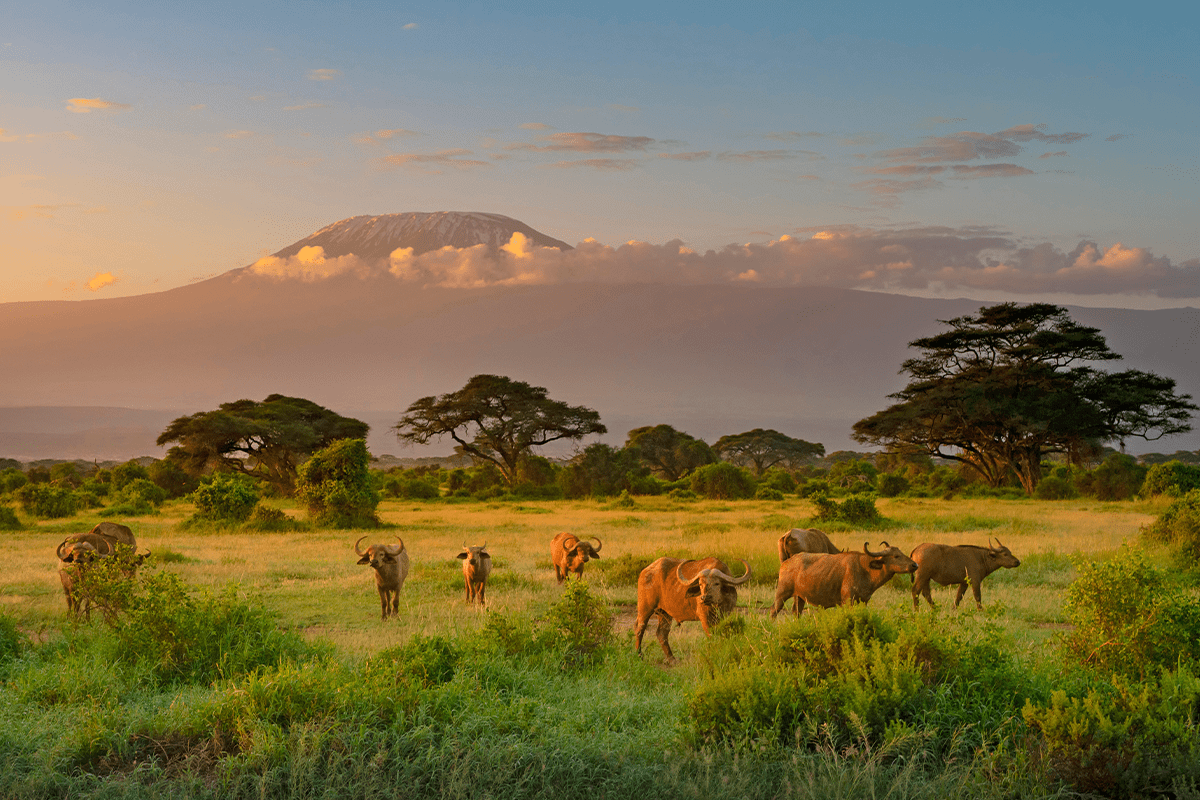 Wild animals with the background of Mount Kilimanjaro. Amboseli National Park, Kenya.
Wild animals with the background of Mount Kilimanjaro. Amboseli National Park, Kenya.
4. Urbanisation and expansion of cities
Urbanisation and the expansion of cities have a significant impact on deforestation, contributing to the destruction of forested land across the globe. As urban areas grow, they require more resources to sustain their populations, increasing demand for products like beef and agricultural goods. This demand fuels deforestation both directly—through the conversion of forested land into housing or agricultural land—and indirectly—by increasing pressure on forests to provide resources.
The expansion of cities often leads to the need for more land for housing and settlements, as well as for the construction of roads and other infrastructure to service the city. In places like Latin America and Sub-Saharan Africa, the expansion of cities has driven significant forest loss over the past few decades. For example, in the past 20 years, Brazil has lost more than 16 million hectares of forested land to urban expansion, mining, and agriculture, with much of this loss occurring in the Amazon region.
As cities expand and their populations grow, the demand for beef and other agricultural products also increases. In many countries, forests are cleared to make way for grazing land for cattle or the cultivation of crops like soybeans and oil palm. In South America, for instance, the expansion of the beef industry has been a significant driver of deforestation in the Amazon basin. Similarly, in Southeast Asia, the widespread development of palm oil plantations has led to massive deforestation, with an estimated 60% of Indonesia's deforestation being attributable to the palm oil industry.
Read more: Green infrastructure: how nature can improve urban living
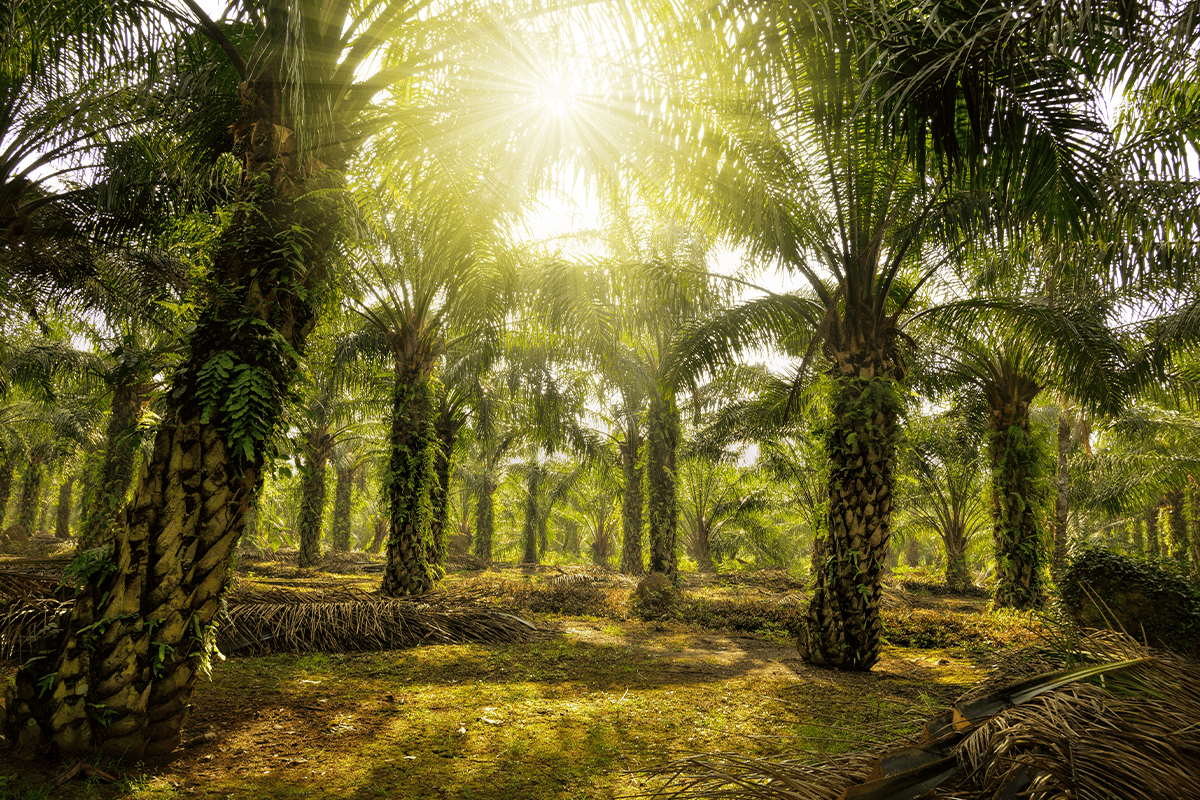 Oil palm tree plantation.
Oil palm tree plantation.
Not only does urbanisation lead to the direct conversion of forested land for urban development and agriculture, but it also indirectly drives deforestation through the increased demand for resources and the displacement of people from urban areas. For example, farmers may be forced to clear forests to gain more acreage for crop production as land becomes more scarce and valuable due to urban expansion.
5. Human population growth
As the world's population continues to grow, the demand for food, housing, and natural resources also increases. This directly impacts deforestation as the need for more land for agriculture and settlements fuels the conversion of forests into farmland and urban areas.
The expansion of agricultural land is one of the major causes of deforestation worldwide. As the population grows, so does the demand for food, which puts pressure on farmers to clear more land to cultivate crops and raise livestock. This has led to the destruction of vast areas of primary forests, particularly in tropical regions such as Latin America and Southeast Asia.
The need for housing and infrastructure to accommodate the growing population also contributes to deforestation. As populations expand, they encroach upon natural habitats, leading to a loss of forest cover and biodiversity. This harms the environment, as forests are essential for carbon sequestration, biodiversity, and climate regulation.
Read more: Breathe easy: How trees are nature's air-cleaning machines
Human activity, such as livestock grazing and intensive crop cultivation, is also fueled by population growth and contributes to deforestation. In many countries, traditional farming practices have given way to more intensive methods that require fertilisers and machinery. This, in turn, puts pressure on natural resources such as water and contributes to soil erosion and land degradation.
To address these issues, it is important to embrace sustainable living and support organisations that actively work to fight deforestation. By adopting eco-friendly practices and choosing products that are sustainably sourced, we can reduce our environmental impact and protect the world's forests.
6. Increased need for resources
The increased need for resources is a major driver of deforestation. The demand for wood products as well as agricultural products, including palm oil and soybeans, have contributed to unsustainable levels of deforestation.
The global demand for wood products has risen significantly over the years. Timber is used for a wide range of products, including paper, furniture, and building materials. The logging industry has grown substantially to meet this demand, leading to the clearing of large areas of forested land.
Forests provide an extensive range of ecosystem services that cannot be replaced by other mechanisms. These include carbon sequestration, habitat provision, soil health, and air quality preservation. Human activities, increased demand, and expanding populations command more from forests, even though forest areas are shrinking. Taking such services for granted puts an imbalance in the ecosystems and promotes an unsustainable way of understanding and relying on nature.
Read more: Deforestation in the United States: causes, consequences, and cures
Agricultural products such as palm oil and soybeans are also major drivers of deforestation. To meet the increasing demand for these products, especially in Asia and South America, vast areas of forests have been cleared to make way for palm oil plantations and soybean fields. This has resulted in extensive forest degradation and biodiversity loss, as well as displacement of Indigenous communities and traditional farming practices.
The resource curse (also the paradox of plenty) is a phenomenon where resource-rich countries face more economic, social, political, and sustainability challenges than countries with fewer resources. In some cases, forests in these countries are cleared to access resources that can be used to generate revenue, often from exporting these resources to other countries (with fewer resources), providing a significant source of income for the ‘resource-cursed’ country.
However, the economic gains from these resources are often short-term, and unsustainable levels of deforestation can have long-lasting negative impacts on the environment and local communities. To tackle global deforestation, it is thus essential that all countries, governments, and private organisations take action, not only on a local level but also with respect to its resource imports, ensuring that all products acquired are sustainably sourced.
7. Slash-and-burn techniques
Slash-and-burn techniques, also known as shifting cultivation, are traditional forest-conversion methods that involve clearing forested land by cutting down trees and then burning the area to clear the land for agriculture or timber plantations. This practice has been commonly used in South America, Asia, and Africa for centuries.
The process of slash and burn involves cutting down trees and vegetation in a particular area, leaving them to dry for several weeks, and then setting fire to the debris. The heat from the fire burns the organic matter in the soil, releasing nutrients that can be used to fertilise the land. After the fire has burned out, crops are planted in the nitrogen-rich soil.
While this technique can provide short-term benefits, the consequences of slash-and-burn techniques on forested land can be severe. The removal of trees and vegetation exposes soil to erosion, which can lead to soil depletion and reduced agricultural productivity over time. As the soil loses its fertility, farmers are forced to clear new areas of forested land, perpetuating a cycle of deforestation.
Furthermore, this practice results in large-scale harm to biodiversity, as it wipes out all insects, small reptiles, and other mammals that cannot escape the burnt area. It destroys natural habitats and leads to the displacement of animal species. Burning vegetation also releases large amounts of carbon dioxide and other greenhouse gases into the atmosphere, depleting the forest's carbon stock and highlighting the problem of emissions caused by deforestation.
Help restore our vital forests by offsetting your emissions
 Field rabbit (Oryctolagus cuniculus) in a green meadow in Humilladero, Malaga province. Andalusia, Spain.
Field rabbit (Oryctolagus cuniculus) in a green meadow in Humilladero, Malaga province. Andalusia, Spain.
8. Expansion of manufacturing and industrial sites
The expansion of manufacturing and industrial sites is one of the major drivers of deforestation worldwide. Industrialisation has brought about an increase in the demand for resources such as wood, minerals, and other raw materials. Additionally, biomass power generation, which uses organic materials derived from forests to generate energy and is the primary energy source in some regions, can be another cause of deforestation if sourced unsustainably. This increase in demand for resources has led to the clearing of forests, resulting in the loss of forest ecosystems and natural habitats.
The consequences of large-scale deforestation for industrial purposes are numerous. Forest ecosystems are complex systems that provide a wide array of benefits, including biodiversity, soil fertility, and carbon sequestration. The loss of forest ecosystems not only results in the displacement of Indigenous communities and animal species but also contributes to increased greenhouse gas emissions.
Some of the key industries responsible for deforestation due to industrial expansion include mining, logging, and oil and gas extraction. Wood production for paper products and agricultural products such as palm oil plantations are also driving deforestation globally. The demand for paper products, including newspapers, books, and packaging materials, has led to the unsustainable harvesting of trees, contributing to deforestation. The expansion of agricultural land, especially for commodities such as soybeans and beef, is another major driver of deforestation in tropical regions.
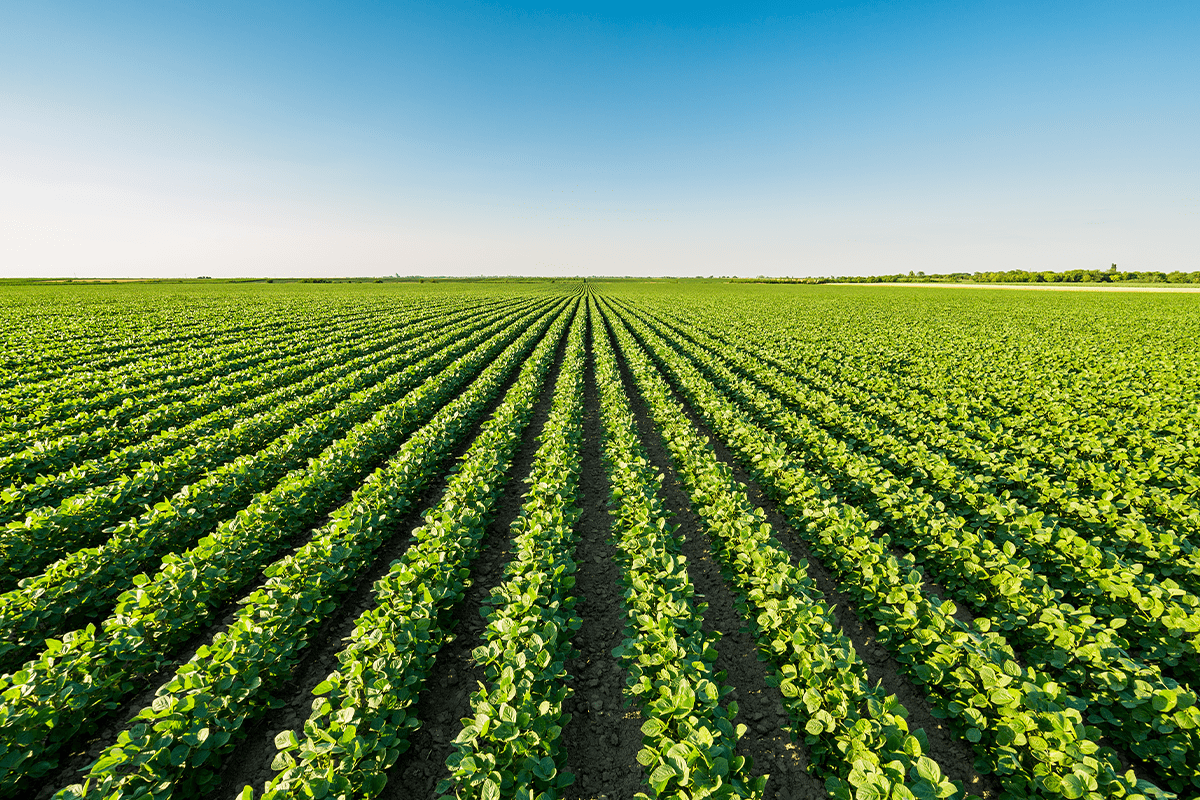 Green ripening soybean field, agricultural landscape.
Green ripening soybean field, agricultural landscape.
Mining is another significant cause of deforestation, as it often necessitates clearing vast forested areas to access valuable mineral and metal deposits. The extraction process involves removing vegetation and altering the natural landscape. Additionally, mining operations require extensive infrastructure development, such as building roads or processing facilities. Such further fragmentation of forest habitats creates barriers to wildlife movement patterns and breeding behaviours of species, altering the ecosystems’ balance.
Contribute to ecosystem restoration with our carbon credits
The consequences of deforestation for industrial purposes are far-reaching and impact numerous sectors. It affects ecosystems and natural habitats and has implications for biodiversity, soil fertility, and carbon sequestration, threatening both primary and secondary forests. As such, there is a pressing need for concerted efforts from stakeholders to promote sustainable production practices and halt the alarming rate of global deforestation.
9. Intensive crop cultivation
Intensive crop cultivation is another leading cause of deforestation worldwide. This farming practice involves the cultivation of crops on a large scale, with high inputs of fertilisers, pesticides, and other chemical additives. This method is often used to produce crops such as soybeans and palm oil, which are in high demand for use in animal feed production, particularly livestock, and various other industries. The demand for meat products has dramatically increased, requiring significant amounts of soy and palm oil to feed the animals. As a result, farmers have cleared vast forest areas to make way for soy and palm plantations, leading to a loss of forested lands and the associated ecological services they offer. However, this current productivity rate comes at a cost in the form of deforestation, soil degradation, and biodiversity loss.
New farming methods and techniques have contributed significantly to the rate of deforestation, as farmers use them to expand their crop cultivation. For example, the use of mechanised equipment such as tractors has made it easier to clear large areas of land for cultivation. Moreover, planting and harvesting crops in rotation has led to the cultivation of larger areas of land, thus increasing the rate of deforestation.
Read more: The roots of a sustainable future: integrating trees into a circular economy
Cyclic agriculture is a promising approach to maintaining soil fertility while avoiding the harmful effects of intensive farming. The aim of cyclic agriculture is to create a closed system where the nutrients present in the soil are continually recycled, reducing the need for chemical additives and fertilisers. Cyclic agriculture also involves crop rotation, intercropping, and agroforestry, all of which contribute to the growth of soil health and fertility while preserving forested lands. Many other sustainable land management practices can also be implemented to ensure more sustainable crop production, such as regenerative farming and conservation agriculture. At DGB, we incorporate various sustainable agricultural techniques through our projects, such as community-based agroforestry and regenerative farming. This approach helps to restore the environment while helping local communities develop sustainably and economically. When you invest in our projects through our carbon credits, you help restore nature and fight deforestation.
10. Over-exploitation of natural resources
Over-exploitation of natural resources is a major cause of deforestation. This occurs when humans extract more resources than the environment can replenish naturally, leading to the depletion of natural resources such as minerals, fossil fuels, and timber. Activities that contribute to this type of deforestation include mining, logging, and oil and gas extraction.
The negative impact of the over-exploitation of natural resources on the environment is significant. When trees are removed from a forested area, the habitats of various animal and plant species are destroyed, leading to a significant loss of biodiversity. Soil erosion also occurs when trees are cut, increasing the amount of sediment that accumulates in rivers and streams. Such sedimentation affects water quality and can lead to further habitat destruction in aquatic environments. Additionally, the release of carbon emissions due to deforestation contributes to an increased carbon footprint associated with human activities.
Read more: Preventing desertification: Top 5 success stories
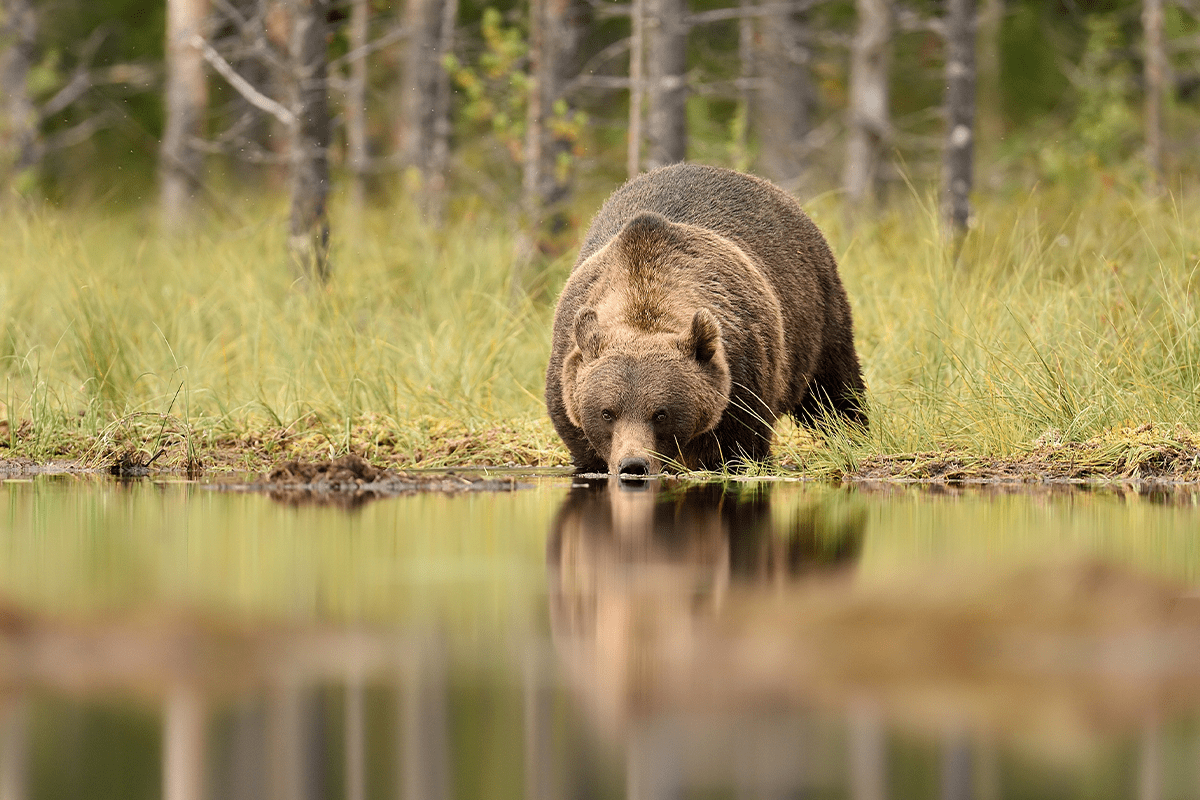 A brown bear drinking water from a forest pond in summer.
A brown bear drinking water from a forest pond in summer.
Minerals, fossil fuels, and timber are some of the most commonly exploited natural resources, contributing greatly to deforestation. Mining for minerals such as gold, silver, and copper often requires clearing large areas of land. Similarly, the demand for fossil fuels, primarily for transportation and electricity generation, has driven companies to extract oil, coal, and natural gas from beneath the earth's surface. As mentioned, the over-exploitation by the logging industry has also led to deforestation, with trees being harvested to produce paper and lumber.
Given the negative impact of over-exploitation of natural resources on the environment, it's important to implement conservation solutions to reduce deforestation. Sustainable forestry practices such as selective cutting and reforestation can help maintain forested lands while still allowing for sustainable timber production. Increasing the number of protected conservation areas can also help prevent further habitat destruction and loss of biodiversity. More fuel-efficient techniques and processes can reduce the strain on forests. Implementing policies that encourage the responsible use of natural resources, such as taxation and regulations, can also help reduce the over-exploitation of natural resources and protect the environment.
Read more: Reforestation: 10 amazing benefits of planting trees
Society, and the processes that support it, is consumer-driven. However, over-exploitation has become an everyday occurrence. If we want to ensure a healthy, prosperous future, global action from individuals to governments is needed to create more sustainable practices and protect our planet’s resources for future generations.
DGB Group, leading the way for reforestation
DGB Group is a company leading the way for reforestation through nature-based solutions. Our approach to reforestation focuses on restoring degraded forests, promoting sustainable agriculture, and empowering local communities through training and agroforestry. DGB's mission is to help nature prosper and flourish, and that means combatting deforestation by restoring the world's forests.
Explore DGB’s nature-based projects
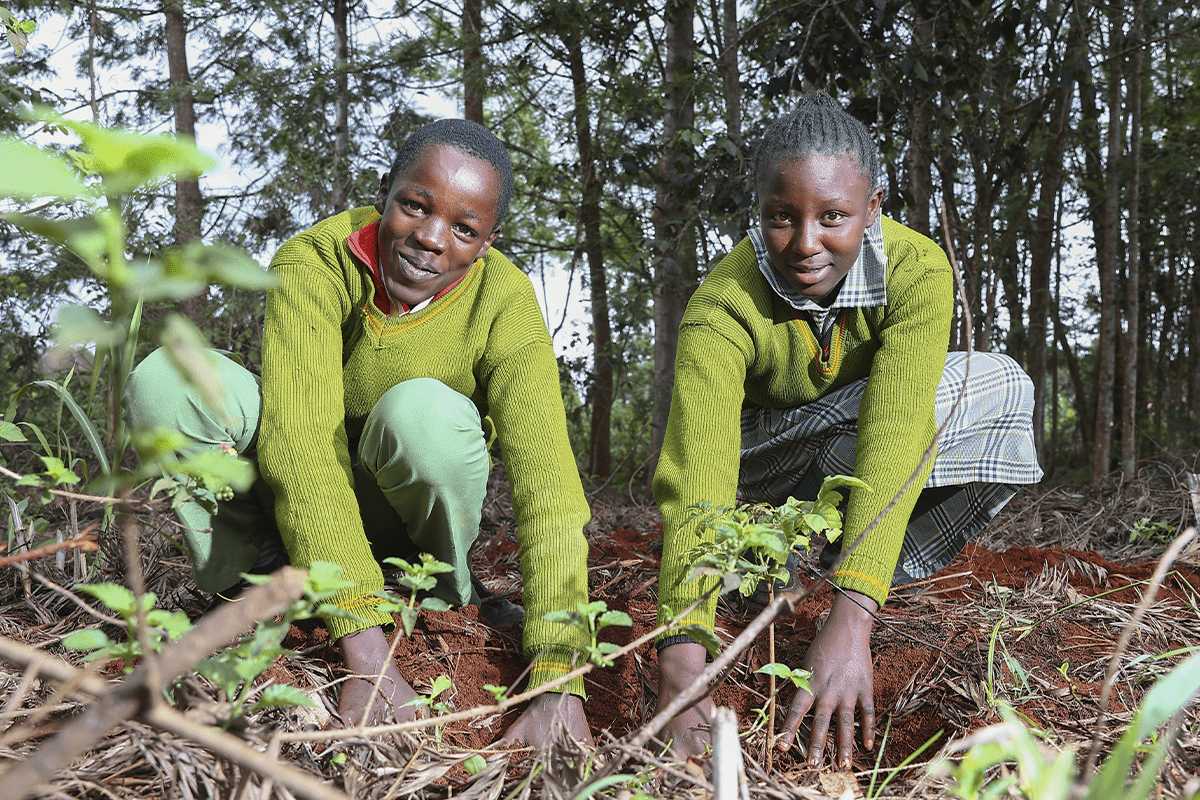 Two pupils planting a seedling, school in Kenya, Kutus area - Hongera Reforestation Project, Kenya, DGB.
Two pupils planting a seedling, school in Kenya, Kutus area - Hongera Reforestation Project, Kenya, DGB.
DGB develops and manages large-scale projects in several countries, including Cameroon, Uganda, Kazakhstan, and Kenya. We have implemented successful reforestation efforts in these countries by working with local communities, governments, landowners, and investors to restore nature at scale. For example, in Uganda, DGB helps to restore degraded forests in the Hoima, Bulindi, and Masindi districts of western Uganda. This led to increased forest cover and improved habitat for the Bulindi chimpanzees.

DGB's projects generate verified, top-quality carbon credits through the carbon emissions captured through our reforestation efforts. Carbon credits (also known as carbon units or CO2 offset certificates) are a vital tool to restore nature as they fund these vital restoration initiatives and help individuals and organisations achieve carbon neutrality. By purchasing our carbon credits, you not only compensate for your carbon footprint but also invest in nature and help to create a greener world.
Join forces with DGB and make a difference through reforestation efforts. Whether you're an individual, investor, or a business, you have the power to make an impact. Let's work together to create a greener world. With your collaboration, we can preserve the world's forests for generations to come.














